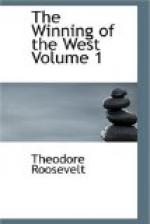The confusion was heightened by the anarchy in which the government of the northwestern district had been thrown in consequence of the quarrel concerning the jurisdiction. The inhabitants were doubtful as to which colony really had a right to their allegiance, and many of the frontier officials were known to be double-faced, professing allegiance to both governments.[48] When the Pennsylvanians raised a corps of a hundred rangers there almost ensued a civil war among the whites, for the Virginians were fearful that the movement was really aimed against them.[49] Of course the march of events gradually forced most, even of the neutral Indians, to join their brethren who had gone on the war-path, and as an example of the utter confusion that reigned, the very Indians that were at war with one British colony, Virginia, were still drawing supplies from the British post of Detroit.[50]
Logan’s rage had been terrible. He had changed and not for the better, as he grew older, becoming a sombre, moody man; worse than all, he had succumbed to the fire-water, the curse of his race. The horrible treachery and brutality of the assault wherein his kinsfolk were slain made him mad for revenge; every wolfish instinct in him came to the surface. He wreaked a terrible vengeance for his wrongs; but in true Indian fashion it fell, not on those who had caused them, but on others who were entirely innocent. Indeed he did not know who had caused them. The massacres at Captina and Yellow Creek occurred so near together that they were confounded with each other; and not only the Indians but many whites as well[51] credited Cresap and Greathouse with being jointly responsible for both, and as Cresap was the most prominent, he was the one especially singled out for hatred.
Logan instantly fell on the settlement with a small band of Mingo warriors. On his first foray he took thirteen scalps, among them those of six children.[52] A party of Virginians, under a man named McClure, followed him: but he ambushed and defeated them, slaying their leader.[53] He repeated these forays at least three times. Yet, in spite of his fierce craving for revenge, he still showed many of the traits that had made him beloved of his white friends. Having taken a prisoner, he refused to allow him to be tortured, and saved his life at the risk of his own. A few days afterwards he suddenly appeared to this prisoner with some gunpowder ink, and dictated to him a note. On his next expedition this note, tied to a war-club, was left in the house of a settler, whose entire family was murdered. It was a short document, written with ferocious directness, as a kind of public challenge or taunt to the man whom he wrongly deemed to be the author of his misfortunes. It ran as follows:
“CAPTAIN CRESAP:
“What did you kill my people on Yellow Creek for? The white people killed my kin at Conestoga, a great while ago, and I thought nothing of that. But you killed my kin again on Yellow Creek, and took my cousin prisoner. Then I thought I must kill too; and I have been three times to war since; but the Indians are not angry, only myself.




